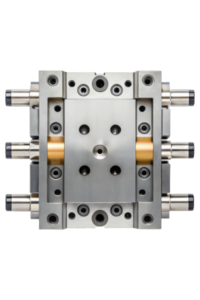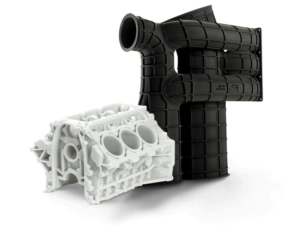Selective Laser Sintering (SLS) is a popular additive manufacturing technique that uses a laser to selectively fuse powdered materials into solid parts. SLS is ideal for producing complex geometries, low-volume parts, and prototypes in a variety of materials including nylon, polycarbonate, and stainless steel.
In this guide, we will discuss the key design considerations for SLS and provide tips to optimize your parts for this printing method.
Understanding the SLS Process
The SLS process starts by spreading a layer of powdered material onto a build platform. A laser then traces the cross-section of the part and fuses the powder together. The platform then lowers, and a new layer of powder is spread on top, repeating the process until the entire part is complete.
SLS Process
It’s important to note that SLS parts are built with a thin layer of unfused powder on the surface, which must be removed post-processing.
Designing for SLS
To ensure your SLS parts are successful, it is essential to understand the design limitations of this process.
Wall Thickness
SLS parts require a minimum wall thickness of 1.5mm to ensure they are strong enough to withstand handling and post-processing. Thinner walls are prone to warping and breakage, so it’s crucial to keep this in mind when designing your parts.
Overhangs and Supports
SLS does not require the use of support structures, making it possible to produce complex geometries and overhangs. However, to avoid warping and ensure the part has enough strength, it is recommended to keep overhangs to less than 45 degrees.
Tolerance
SLS parts have an average tolerance of +/- 0.5% of the part’s dimensions. This tolerance can vary depending on the material and design, so it’s essential to keep this in mind when designing critical parts.
Material Considerations
SLS materials have varying mechanical properties, such as strength and stiffness, which can impact the design of your parts. It’s essential to select the right material for your application to ensure the part performs as expected.
Optimizing Your Design for SLS
To optimize your design for SLS, consider the following tips:
- Design with a minimum wall thickness of 1.5mm
- Limit overhangs to less than 45 degrees
- Consider the tolerance of the printing method
- Select the right material for your application
Conclusion
In conclusion, SLS is an excellent printing method for producing complex geometries and low-volume parts. By understanding the design limitations and optimizing your design, you can ensure your SLS parts are successful and meet your requirements.
By following the tips outlined in this article, you can design parts that are optimized for Selective Laser Sintering and produce high-quality, functional parts that meet your requirements. For more information please go to https://quickparts.com/.
https://goo.gl/maps/YFnnaxBSUpxJMd3SA
https://maps.google.com/maps?cid=16887780228240572250


